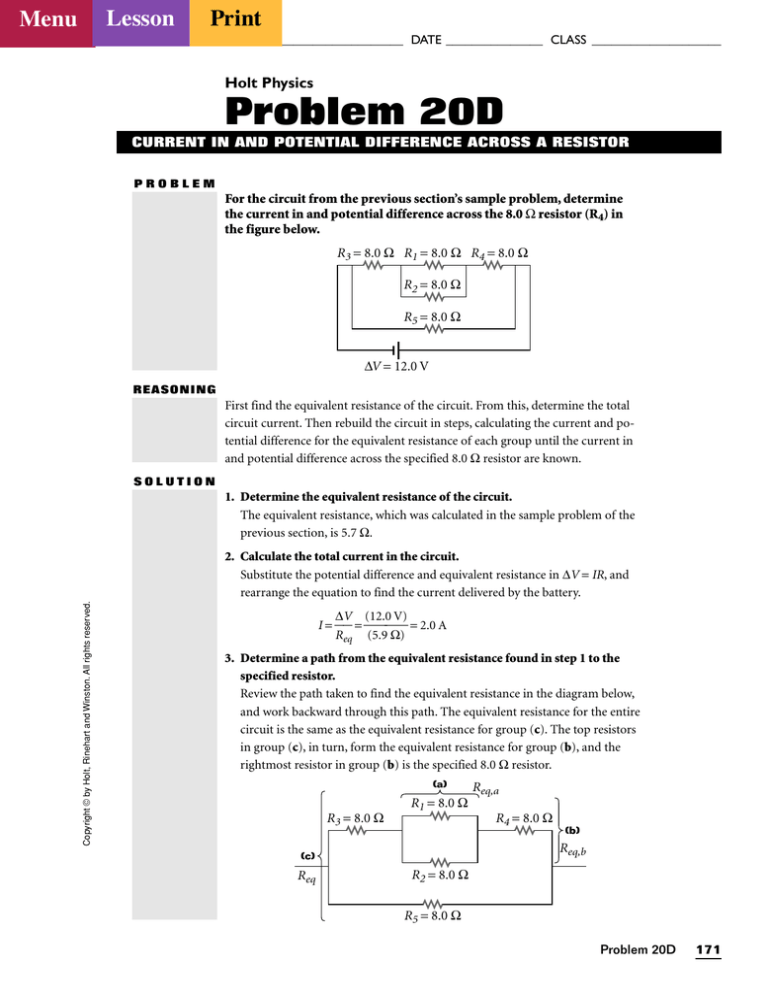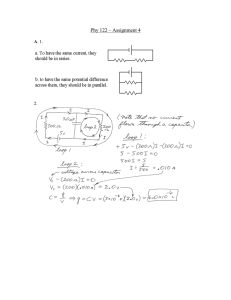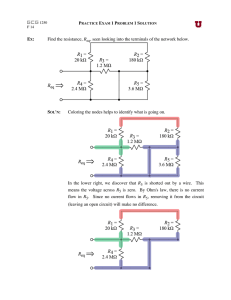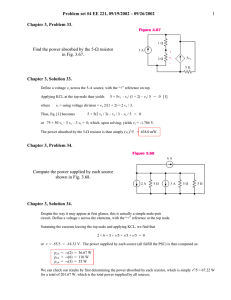
Lesson
Menu
Print
NAME ______________________________________ DATE _______________ CLASS ____________________
Holt Physics
Problem 20D
CURRENT IN AND POTENTIAL DIFFERENCE ACROSS A RESISTOR
PROBLEM
For the circuit from the previous section’s sample problem, determine
the current in and potential difference across the 8.0 Ω resistor (R4) in
the figure below.
R3 = 8.0 Ω R1 = 8.0 Ω R4 = 8.0 Ω
R2 = 8.0 Ω
R5 = 8.0 Ω
∆V = 12.0 V
REASONING
First find the equivalent resistance of the circuit. From this, determine the total
circuit current. Then rebuild the circuit in steps, calculating the current and potential difference for the equivalent resistance of each group until the current in
and potential difference across the specified 8.0 Ω resistor are known.
SOLUTION
1. Determine the equivalent resistance of the circuit.
The equivalent resistance, which was calculated in the sample problem of the
previous section, is 5.7 Ω.
Copyright © by Holt, Rinehart and Winston. All rights reserved.
2. Calculate the total current in the circuit.
Substitute the potential difference and equivalent resistance in ∆V = IR, and
rearrange the equation to find the current delivered by the battery.
∆V (12.0 V)
I = = = 2.0 A
Req (5.9 Ω)
3. Determine a path from the equivalent resistance found in step 1 to the
specified resistor.
Review the path taken to find the equivalent resistance in the diagram below,
and work backward through this path. The equivalent resistance for the entire
circuit is the same as the equivalent resistance for group (c). The top resistors
in group (c), in turn, form the equivalent resistance for group (b), and the
rightmost resistor in group (b) is the specified 8.0 Ω resistor.
(a)
R3 = 8.0 Ω
R1 = 8.0 Ω
R4 = 8.0 Ω
(b)
Req,b
(c)
Req
Req,a
R2 = 8.0 Ω
R5 = 8.0 Ω
Problem 20D
171
Menu
Lesson
Print
NAME ______________________________________ DATE _______________ CLASS ____________________
4. Follow the path determined in step 3, and calculate the current in and potential difference across each equivalent resistance. Repeat this process
until the desired values are found.
Regroup, evaluate, and calculate.
Replace the circuit’s equivalent resistance with group (c), as shown in the figure. The resistors in group (c) are in parallel, so the potential difference across
each resistor is equal to the potential difference across the equivalent resistance,
which is 12.0 V. The current in the equivalent resistance in group (b) can now
be calculated using ∆V = IR.
Given:
∆V = 12.0 V
Unknown:
Ib = ?
Req,b = 20.0 Ω
∆V
(12.0 V)
Ib = = = 0.600 A
Req,b (20.0 Ω)
Regroup, evaluate, and calculate.
Replace the 20.0 Ω resistor with group (b). The resistors R3 , Req,b , and R4 in
group (b) are in series, so the current in each resistor is the same as the current in the equivalent resistance, which equals 0.600 A.
Ib = 0.600 A
The potential difference across the 8.0 Ω resistor at the right can be calculated
using ∆V = IR.
Given:
Ib = 0.600 A
Unknown:
∆V = ?
R4 = 8.0 Ω
∆V = IR = (0.600 A)(8.0 Ω) = 4.8 V
ADDITIONAL PRACTICE
1. Recall from the previous section the high-powered searchlight with the
power rating of 6.0 × 105 W. For a potential difference of 220 V placed
across the light bulb of this searchlight, you found a value for the bulb’s
resistance. You also determined the equivalent resistance for the circuit
shown in the figure below.
R1
R2
R6
R3
R4
R5
∆V = 220 V
a. Calculate the potential difference across and current in the searchlight bulb labeled R3.
172
Holt Physics Problem Workbook
Copyright © by Holt, Rinehart and Winston. All rights reserved.
The current through the specified resistor is 0.600 A, and the potential difference across it is 4.8 V.
Lesson
Menu
Print
NAME ______________________________________ DATE _______________ CLASS ____________________
b. Calculate the potential difference across and current in the searchlight bulb labeled R2.
c. Calculate the potential difference across and current in the searchlight bulb labeled R4.
2. Recall the portable power pack that can provide 12 V for 40.0 h. The
device powers a combination of small appliances with the resistances
shown in the circuit diagram below. In the previous section, you calculated the equivalent resistance and net current for this circuit.
R1 = 2.5 Ω R2 = 3.5 Ω
R4 = 4.0 Ω
R3 = 3.0 Ω
R5 = 1.0 Ω
∆V = 12 V
Copyright © by Holt, Rinehart and Winston. All rights reserved.
a. Calculate the potential difference across and current in the 1.0 Ω
appliance.
b. Calculate the potential difference across and current in the 2.5 Ω
appliance.
c. Calculate the potential difference across and current in the 4.0 Ω
appliance.
d. Calculate the potential difference across and current in the 3.0 Ω
appliance.
3. Recall the longest-lasting battery in the world, which was constructed at
Oxford University in 1840. In 1977, the terminal voltage of the battery
was 2.00 × 103 V. Suppose the battery is placed in the circuit shown in the
diagram below. Determine the equivalent resistance of the circuit, and
then find the following:
R2 = 3.0 Ω R3 = 2.0 Ω R5 = 7.0 Ω R 6 = 3.0 Ω
R 4 = 5.0 Ω
R7 = 3.0 × 101 Ω
R1 = 15 Ω
∆V = 2.00 × 103 V
a.
b.
c.
d.
the potential difference and current in the 5.0 Ω resistor (R4).
the potential difference and current in the 2.0 Ω resistor (R3).
the potential difference and current in the 7.0 Ω resistor (R5).
the potential difference and current in the 3.0 × 101 Ω resistor (R7).
Problem 20D
173
Menu
Lesson
Givens
Print
Solutions
4. ∆V = 1.00 × 103 V
R1 = 1.5 Ω
R2 = 3.0 Ω
R3 = 1.0 Ω
! " !
"
1
1
1
= 0.67 + 0.33 = 1.00
! Ω Ω" ! Ω"
1
1
R12 = +
R1 R2
R12
−1
1
1
= +
1.5 Ω 3.0 Ω
−1
−1
−1
= 1.00 Ω
Req = R12 + R3 = 1.00 Ω + 1.0 Ω = 2.0 Ω
(∆V )2 (1.00 × 103 V)2
P = = = 5.0 × 105 W
Req
2.0 Ω
5. ∆V = 2.00 × 103 V
I = 1.0 × 10−8 A
R1 = r
R12 = R1 + R2 = r + 3r = 4r
R34 = R3 + R4 = 2r + 4r = 6r
R2 = 3r
!
" = !4r + 6r"
5
3+2
12
= = = r
! 12r " !12r" 5
1
1
Req = +
R12 R34
R3 = 2r
II
∆V 2.00 × 103 V
Req = =
= 2.0 × 1011 Ω
I
1.0 × 10−8 A
R4 = 4r
−1
Req
−1
1
1
−1
−1
5
5
r = Req = (2.0 × 1011 Ω) = 8.3 × 1010 Ω
12
12
6. P = 6.0 × 105 W
∆V = 220 V
(∆V)2
(220 V)2
R = =
= 8.1 × 10−2 Ω
P
6.0 × 105 W
R12 = R45 = 2R = 2(0.081 Ω) = 0.16 Ω
R12345
−1
"
1
1
1
= + +
0.16 Ω 0.081 Ω 0.16 Ω
−1
−1
= 0.042 Ω
Req = R12345 + R6 = 0.042 Ω + 0.081 Ω = 0.123 Ω
(∆V)2 (220 V)2
P = = = 3.9 × 105 W
Req
0.123 Ω
Additional Practice 20D
1. R = 8.1 × 10−2 Ω
Req = 0.123 Ω
∆V
220 V
a. I = = = 1800 A
Req 0.123 Ω
∆V = 220 V
∆V12345 = IR12345 = (1800 A)(0.042 Ω) = 76 V
R12 = R45 = 0.16 Ω
∆V3 = ∆V12345 = 76 V
R12345 = 0.042 Ω
∆V
76 V
I3 = 3 =
= 9.4 × 102 A
R3
8.1 × 10−2 Ω
II Ch. 20–4
Holt Physics Solutions Manual
−1
Copyright © by Holt, Rinehart and Winston. All rights reserved.
!
" !
1
1
1
1
= 6.2 + 12 + 6.2 = 24
! Ω Ω Ω" ! Ω"
1
1
1
R12345 = + +
R12 R3 R45
Lesson
Menu
Givens
Print
Solutions
b. ∆V12 = ∆V12345 = 76 V
∆V12
76 V
I12 =
= = 4.8 × 102 A
R12
0.16 Ω
I2 = I12 = 4.8 × 102 A
∆V2 = I2R2 = (4.8 × 102 A)(8.1 × 10−2 Ω) = 39 V
c. Same as part b:
I4 = 4.8 × 102 A
∆V4 = 39 V
2. ∆V = 12 V
R1 = 2.5 Ω
R3 = 3.0 Ω
R4 = 4.0 Ω
R5 = 1.0 Ω
R12 = 6.0 Ω
a. ∆V45 = IR45 = (4.3 A)(0.83 Ω) = 3.6 V
∆V5 = ∆V45 = 3.6 V
∆V
3.6 V
I5 = 5 = = 3.1 A
R5
1.0 Ω
b. ∆V123 = IR123 = (4.3 A)(2.0 Ω) = 8.6 V
R123 = 2.0 Ω
∆V12 = ∆V123 = 8.6 V
R45 = 0.83 Ω
∆V12 8.6 V
I1 = I12 =
= = 1.4 A
R12
6.0 Ω
Req = 2.8 Ω
I = 4.3 A
II
∆V1 = I1R1 = (1.4 A)(2.5 Ω) = 3.5 V
c. I45 = I = 4.3 A
∆V45 = I45 R45 = (4.3 A)(0.83 Ω) = 3.6 V
Copyright © by Holt, Rinehart and Winston. All rights reserved.
V4 = ∆V45 = 3.6 V
∆V
3.6 V
I4 = 4 = = 0.90 V
R4
4.0 Ω
d. ∆V3 = ∆V123 = 8.6 V
∆V
8.6 V
I3 = 3 = = 2.9 A
R3
3.0 Ω
Section Two—Problem Workbook Solutions
II Ch. 20–5
Menu
Lesson
Givens
Print
Solutions
3. R1 = 15 Ω
R2 = 3.0 Ω
R23 = R2 + R3 = 3.0 Ω + 2.0 Ω = 5.0 Ω
! " = !5.0Ω + 5.0Ω"
1
= 0.40 = 2.5 Ω
! Ω"
R3 = 2.0 Ω
1
1
R234 = +
R23 R4
R4 = 5.0 Ω
R234
R5 = 7.0 Ω
R6 = 3.0 Ω
R7 = 3.0 × 101 Ω
∆V = 2.00 × 103 V
−1
1
1
−1
−1
R56 = R5 + R6 = 7.0 Ω + 3.0 Ω = 10.0 Ω
! " !
"
1
1
1
= 0.100 + 0.033 = 0.133
! Ω Ω" ! Ω"
1
1
R567 = +
R56 R7
R567
−1
1
1
= +
10.0 Ω 30 Ω
−1
−1
−1
= 7.52 Ω
Req = R1 + R234 + R567 = 15 Ω + 2.5 Ω + 7.52 Ω = 25 Ω
∆V 2.00 × 103 V
a. I = = = 80 A
Req
25 Ω
∆V234 = IR234 = (80 A)(2.5 Ω) = 2.0 × 102 V
II
∆V4 = ∆V234 = 2.0 × 102 V
∆V
200 V
I4 = 4 = = 4.0 × 101 A
R4
5.0 Ω
b. ∆V23 = ∆V234 = 200 V
∆V23 200 V
I23 =
= = 40 A
R23
5.0 Ω
I3 = I23 = 4.0 × 101 A
∆V3 = I3R3 = (40 A)(2.0 Ω) = 8.0 × 101 V
V567 = I567R567 = (80 A)(7.52 Ω) = 600 V
∆V56 = ∆V567 = 600 V
∆V56 600 V
I56 =
= = 60 A
10.0 Ω
R56
I5 = I56 = 6.0 × 101 A
∆V5 = I5R5 = (60 A)(7.0 Ω) = 4.2 × 102 V
d. ∆V7 = ∆V567 = 6.0 × 102 V
∆V
600 V
I7 = 7 = = 2.0 × 101 A
R7
30 Ω
II Ch. 20–6
Holt Physics Solutions Manual
Copyright © by Holt, Rinehart and Winston. All rights reserved.
c. I567 = I = 80 A








